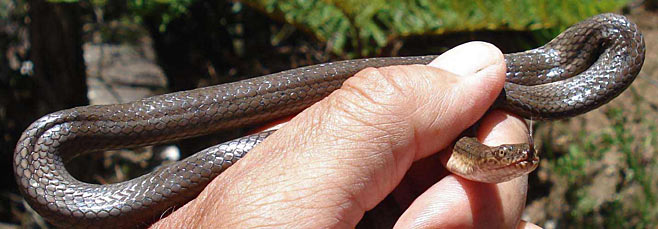|
Lycodonomorphus laevissimus (Dusky-bellied water snake, Black
water snake)
Swartwaterslang [Afrikaans]; Ivuzamanzi limnyama [Zulu];
Inyushu emdaka [Xhosa]
Life >
Eukaryotes
>
Opisthokonta >
Metazoa
(animals) > Bilateria > Deuterostomia >
Chordata >
Craniata > Vertebrata (vertebrates) > Gnathostomata (jawed vertebrates) >
Teleostomi (teleost fish) > Osteichthyes (bony fish) > Class:
Sarcopterygii (lobe-finned fish) > Stegocephalia (terrestrial vertebrates) >
Tetrapoda
(four-legged vertebrates) > Reptiliomorpha > Amniota >
Reptilia (reptiles) >
Romeriida > Diapsida > Lepidosauromorpha > Lepidosauria >
Squamata > Serpentes
(snakes) > Family: Colubridae > Subfamily:
Boodontinae > Genus:
Lycodonomorphus
 |
|
Lycodonomorphus laevissimus (Dusky-bellied or Black
water snake). It was seen hunting a small `common river frog` in shallow water
of the Blyde River (Mpumalanga, South Africa). [A. Marais ©, from
SARCA Virtual Museum] |
Identification
The Dusky-bellied water snake can be identified by its
aquatic lifestyle, a brown or black colouration, a spotted underside, dark spots
on the upper lip and ability to give off a foul smell. It grows to an average
length of 1 meter but can reach 1.2 meters.
Distribution and habitat
The distribution of this snake is restricted the Eastern
Cape and KwaZulu-Natal coast line and a narrow band up into Mpumalanga. Their preferred
habitat includes rivers and vleis in moist savanna.
Food
Eats
frogs,
tadpoles and fish.
Predators, parasites and disease
Eaten by other snakes,
water mongooses, monitor lizards and
birds of
prey (e.g.
snake eagles)
Reproduction
Oviparous (egg-laying), lays between 4 and 17 eggs.
Longevity
Likely to have an average lifespan of
10 years.
Medical importance
Non-venomous and not dangerous to man but will bite if
threatened.
Links
References
-
Broadley, D.G. 1983. FitzSimons' Snakes of Southern
Africa. Delta Books, Johannesburg.
-
Marais, J. 2004. A Complete Guide to Snakes of Southern Africa. Struik Publishers, Cape Town.
|
